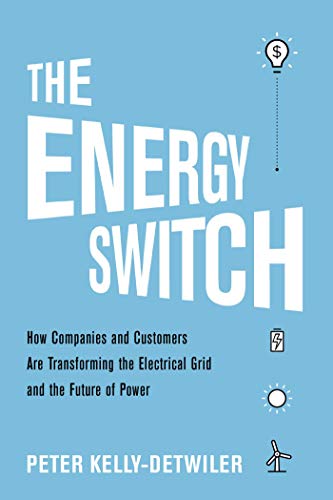6 Electric Energy Predictions for 2022 with Peter Kelly-Detwiler
Energy industry thought leader Peter Kelly-Detwiler joined us on the Bigger Than Us podcast in January to share his predictions for electric energy in 2022. Here are six key takeaways, all of which are centered around the areas he believes will be the most interesting to watch this year: storage, electric vehicles, and hydrogen.
These quotes have been lightly edited for brevity and readability.
1. Real Progress on Hydrogen Projects
(42:57) “I’m looking to 2022 to see the first real steel in the ground projects that show us that this is more than hype. There’s reason for hope here…we see the first footings in the ground, if you will, for that industry to move forward and demonstrate the potential that it may be able to reach.”
2. EVs Will Truly Come of Age
(3:43) “If you look at, for example, electric vehicle sales in Europe, the numbers are really quite significant. And even here in [the US], more than double what they were last year. In places like France, one every six new vehicles has a plug in it. We’re not quite at that level yet. Norway has 80% of its new vehicles that are registered or electric.”
(42:46) “Tesla’s [no longer] this incredible outlier in terms of the technology and the beauty of what they’ve created. I think a lot more companies are coming into the space with a really nice product, like the Ford F-150 Lightning — that one knocks my socks off.
The fact that a car can power a home for three to five days, depending upon the size of the battery. I think that vehicle to [everything] capability by the way, it’s going to be inevitable. Once you see it in the market, everyone’s going to want it.”
3. Battery Costs May Be Under Pressure
(40:36) “I think we’re going to see battery costs under some pressure, especially as we get more models and more demand out there. The supply chain will have difficulty catching up with just the simple amount of lithium, and cobalt and class-one nickel that we’re going to need, etc. I think those things are going to rear their ugly heads.”
4. Storage Will Scale Alongside Renewables
(41:35) “[Storage is] the inevitable or necessary dance partner of renewables. You need more storage to integrate more wind and solar into the mix.”
I was pleased to see, for example, we put in 3,500 megawatt-hours of storage in the United States in Q3. I think in 2019, the total for the whole year was 777 megawatt-hours for the entire year. So, that trajectory looks like it’s really going to take off. We’re going to do really well in Q4, and then 2022 looks pretty solid there.”
5. Storage & Solar Go Hand in Hand
(4:17) “More batteries are being deployed across the entire energy landscape, particularly here in the United States, and often accompanying solar. And that trend will just continue.
(8:42) “There’s two reasons [why storage is linked to solar]: One, the investment tax credit. If you supply a battery with over 75% solar energy that’s metered, you get that percentage times the available investment track, tax credit, and that doesn’t exist for wind.
The other one is, solar has a very, very predictable production profile, assuming no clouds from eight in the morning to, say, four in the afternoon. And so, there’s this real value in time shifting the energy from that solar panel and moving it to the peak hours of the day.
So, you’re starting to see even retrofits…many projects going on solar and storage, solar and storage. But now you’re seeing more and more companies say, ‘We’re going to go and retrofit existing storage installations because of this thing called negative covariance,’ which is kind of like drinking beer. The first beer is good. The second one’s okay. By the fifth one, not so much utility left there. Same thing. As you add more and more solar into the system, you decrease the value of solar overall. And so prices come down the net value of the next unit coming on board because you start to saturate the system.
But if you can move those solar rich hours of the day, that energy to the evening, now there’s a lot of value there again. So, those two dynamics, the tax structure, and the predictable load shape of solar that allows you to load shift is really helpful when you see some storage matchups, but not as much as solar.”
6. Storage Duration Will Continue to Increase
(10:25) “With lithium ion, you’re typically seeing…somewhere in the two to four-hour range. A lot of the bigger solar projects have four hours of duration, because that’s kind of a length of peak. That’s where your value tends to be concentrated. But as you start to bring in more and more batteries and renewables into the grid, you start to solve for that short-term problem of moving four hours.
Now you have to start to solve these issues: what happens when there’s a lot of cloudy days in a row, or the wind isn’t blowing with the intensity that one expected or needs? Then you start to see the need for these eight, 10, 12-hour duration technologies. So, the flow batteries come in.
I think San Diego Gas Electric just announced a project with the flow batteries with ESS that I saw this morning. You’re starting to see companies like Highview Power that freeze air. And when the air expands again, it increases 700 times in volume and drives a turbine. Those are like 10-hour duration machines.
And then you’re seeing companies like Energy Ball, which stack 35-ton bricks and raise and lower them to deliver energy into the grid. And they’re capable of, say, a 10-hour duration product.
There are others as well. There’s a big set of projects going into California which would be compressed air under reservoirs. And those things are also a longer duration. Then you see companies like Form Energy with a reversible rust battery technology, which is pretty cool. That might have 100 plus hours of duration.
You’re starting to see the first pioneers this year, but a lot more deployments to come in the years to come of this longer duration stuff that picks up the baton from the lithium ion, which gets less cost effective as you get to four to six hours. And then these other technologies come to inherit this longer duration need, which we’ll eventually evolve into as we see more saturation of renewables and lithium covering the shorter duration needs.”

About Peter Kelly-Detwiler
Peter Kelly-Detwiler has 30 years of experience in the electric energy arena. He writes for Forbes.com and other publications on topics related to disruptive innovation and its impact on the electricity infrastructure. He provides strategic advice to clients and investors, helping them to navigate this transitional period. Peter is also the author of The Energy Switch — a book about how companies and customers are transforming the electrical grid and the future of power.
Hear more insights in the full interview with Peter Kelly-Detwiler on episode #180 of the Bigger Than Us Podcast.
- #240 Michael Sheldrick, Co-Founder of Global Citizen - April 12, 2024
- #239 Vince Beiser, Author of The World in a Grain: The Story of Sand and How It Transformed Civilization - April 12, 2024
- #238 Steve Oldham, CEO of Captura - April 12, 2024



